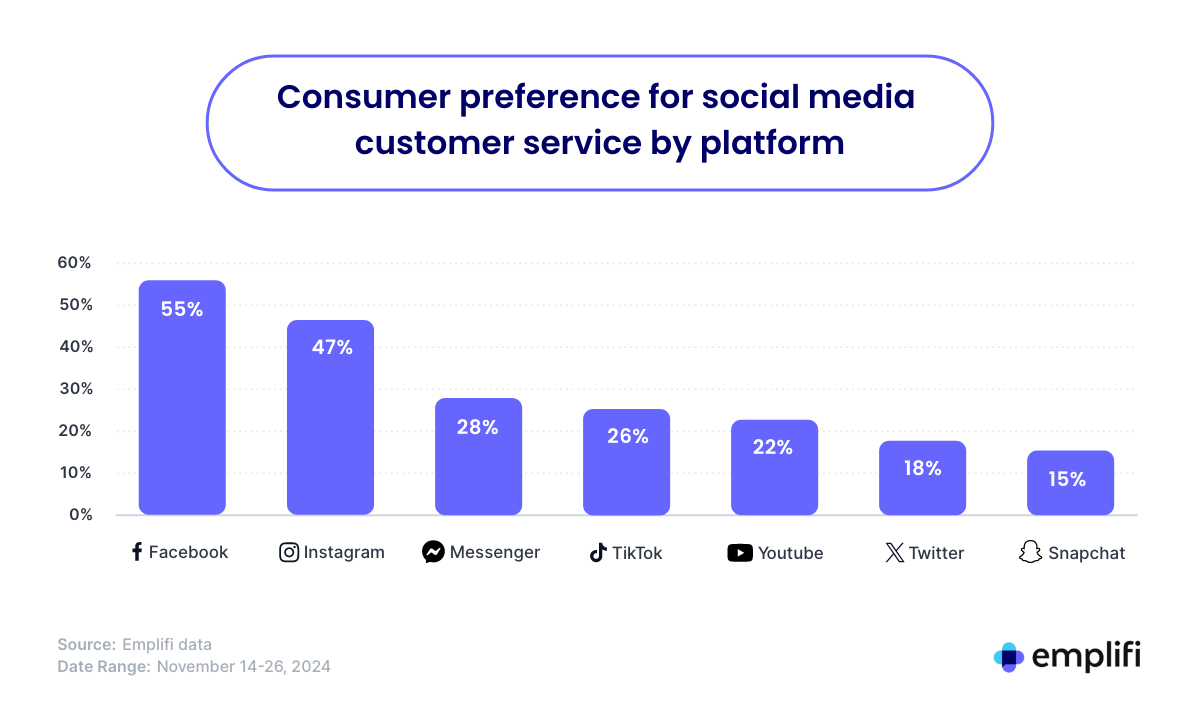You know your customers are on social media. But did you also know that’s where they prefer customer service interactions?
No matter the platform, consumers today expect social media customer service options from the brands they follow. They may initially follow brand social accounts for entertainment and information, but they also turn to those accounts to get their questions answered and their issues resolved.
And they expect responses fast. Over one-third of consumers expects replies to tags and DMs within one hour, and most want a reply within 24 hours, max, according to Emplifi’s 2025 brand engagement survey.
Given this, a customer service strategy that leaves out social media customer service will fall flatter than an outdated meme on Instagram.
Let’s dive into how you can harness social customer service and make it your brand’s superpower.
What is social media customer service?
Social media customer service is the practice of proactively listening to customers on social media and responding to their needs.
This entails tracking brand mentions across platforms and responding to customers there. It includes any methods you offer for customers to talk to you – comments, DMs, chatbots, forms, etc.
When social media customer service is done well, it can skyrocket your brand’s reputation. Giving customers options to get help on the platforms where they’re already engaged creates a positive feedback loop.
How is social media reshaping modern customer support?
While some people, especially Boomers and Gen X-ers, prefer to pick up the phone for customer service, Millennials and Gen Z turn to social media for customer support, especially Instagram and Facebook.
What sets social media customer service apart from traditional customer service are the expectations of speedy responses, and the more casual, sometimes oblique, often public nature of the communication.
For example, a traditional customer service interaction might involve a confused customer sending an email to ask a question. They don’t expect a reply outside of normal business hours, and the interaction remains one on one.
With social media customer service, that interaction could come in the form of a public TikTok video, complaining about your brand to thousands (sometimes millions) of followers. The creator might expect the brand to respond publicly in the comments, and often right away. If your response isn’t quick and appropriately worded, you could have a mini-PR crisis on your hands.
On the flip side, social media customer service opens up a whole world of opportunities for positive, preemptive customer care. Responding to happy customers is just as important as getting back to irritated ones. It can mean the difference between your online audience supporting your brand or turning on it.
Which social platforms should I focus on for customer support?
The answer to which platforms to focus on? Depends on your brand and your audience’s preferences.

Consumer Preference for Social Media Customer Service by Platform
Facebook (55%)
Instagram (47%)
Messenger (28%)
TikTok (26%)
Youtube (22%)
X (18%)
Snapchat (15%)
From Emplifi’s 2025 Brand engagement survey
The best way to determine where to focus is to figure out where your customers already are. If your main demographic is Gen Z, you’ll likely want to focus on TikTok and Instagram. For older generations, Facebook is crucial.
You’ll also want to consider the norms of your industry. Gaming enthusiasts, for example, are more likely to hang out on Discord or Reddit.
Wherever your brand has an account, there should be a customer service element, clearly communicated in a bio or account page. For example, you might create an account on X that’s exclusively for customer support, and link to it on your brand’s main handle. Or, if you only respond to Facebook customer service requests during local business time hours, that information can go on your company page.
Whenever you show up as a brand, you’ll need to show up for customer support, too.
What are the best practices for social media customer service?
There are several elements of social customer care that matter most:
- Speed. Customers demand answers and responses quickly. The ideal time is within one hour (expected by 35% of consumers) and never longer than 24 hours, if possible.
- Human-centered. People understand that AI and chatbots can offer fast replies, but they still prioritize human-backed communication. Augmenting chatbots with options to connect with a human when a more nuanced response is needed provides the perfect balance.
- Tone. It’s vital that your responses are appropriate for the situation. If a customer’s having a serious issue that’s negatively impacting them, it’s not the time for humor. But a brand voice-aligned, well-timed joke can leave customers and followers with a positive impression of your products. Molding a response depending on tone and context is vital.
Another important aspect of a thriving social media customer care program is understanding that you’re entering a conversation. It’s not always going to be a straight, simple Q&A exchange. You’ll want to tailor your communication style to the platform and know the context – sometimes, you’re jumping into an ongoing thread.
What tools can help improve my brand’s social media customer care?
There are many fantastic tools to help manage your social media customer care across platforms.
- Unified inboxes: Look for tools with unified inboxes that consolidate messages across all social platforms into a single dashboard. This prevents missed messages and ensures consistent response times.
- AI features: AI-powered solutions can offer automated routing that directs inquiries to the right team members based on content, urgency, or customer history. AI solutions can resolve customer queries 52% faster than human-backed customer service agents on their own.
- Sentiment analysis capabilities: Sentiment analysis capabilities help prioritize negative comments that require immediate attention, while chatbots can handle common questions, freeing your team to focus on complex issues.
- Integration: The most effective social media customer care platforms integrate with your existing CRM systems, giving agents complete customer context during interactions. This enables personalized responses that acknowledge customer history and previous purchases. Emplifi’s unified, scalable social media management platform is built for teams of any size and integrates all of your social, marketing, and customer care functions in one place.
How do I measure the success of my customer service efforts on social media?
Measuring your social media customer service efforts is crucial for continuous improvement and demonstrating value. Here are five areas to track to see the impact of your approach:
- Response time metrics
• Average first reply time: Aim to beat the industry benchmark (73% expect responses within 24 hours).
• Average resolution time: Track how quickly issues are fully resolved and compare performance against industry benchmarks and your historical data.
- Customer satisfaction metrics
• CSAT scores: Implement post-interaction surveys.
• Net Promoter Score (NPS): Gauge overall customer loyalty.
• Resolution rate: Track the percentage of issues successfully resolved.
- Volume and efficiency metrics
• Total conversations: Monitor overall workload.
• Messages per conversation: Assess efficiency in problem-solving.
• Peak activity times: Identify when to allocate more resources.
- Conversion and business impact metrics
• Click-through rates: Measure the effectiveness of solution links provided
• Support-generated sales: Track revenue directly attributed to support interactions
- ROI demonstration
• Combine metrics to showcase the financial impact of your social customer service investments
By consistently tracking these key performance indicators, you can learn and adjust your social customer service strategy to maximize its value to the business.
Which brands are excelling at social media customer service and why?
Several brands stand out for their exceptional social media customer support, leveraging tools to enhance response times, engagement, and overall customer satisfaction.
AeroMexico elevates brand loyalty with AI assistance
AeroMexico transformed its digital customer service with AI-powered automation, allowing the airline to manage high volumes of inquiries. By implementing chatbots and AI-assisted responses, AeroMexico reduced response times by 80% (from an average of 4 days to mere hours) ensuring travelers receive timely, accurate information. The brand also brings in human agents when more complex issues arise, which balances speed with a personal touch.
Domino’s reduces response times by 53%
Domino’s has mastered real-time social media engagement, using Emplifi’s platform to monitor and respond to customer inquiries across multiple channels. Their approach prioritizes speed and consistency, addressing everything from order issues to customer praise in minutes. Their response time for social care interactions dropped by 53%. A key success factor is that Domino’s actively seeks out customer feedback to improve experiences, before complaints arise, keeping hungry customers happy.
Freshpet builds trust with customers
Freshpet excels by turning customer interactions into meaningful conversations. Using Emplifi’s social media customer service platform, they track customer sentiment and respond with personalized messages, which helps to foster trust and brand advocacy. Their team goes beyond standard support, often sharing pet care tips and celebrating customer stories, making their social presence feel more like a supportive community than a corporate channel.
These brands succeed because they prioritize responsiveness, personalization, and proactive engagement – key elements of a best-in-class social media support strategy.
How can I overcome common challenges in social customer care?
Well, a top challenge may very well be your workload, given that 53% of marketers are overwhelmed by the number of channels they manage.
Consumers have high expectations and low thresholds for mistakes. Eighty percent of U.S. consumers say that speed, convenience, knowledgeable help, and friendly service are key elements of a positive customer service experience. And 46% of consumers would leave a brand after two poor experiences, and 24% are through after just one.
Here are some strategies for managing the most common challenges:
- Streamline inputs: Give your customer care team a platform that unifies all customer messages, across every platform. This enables the team to seamlessly track and respond to customers all from one place.
- Integrate AI to complement your human-led efforts: Using custom chatbots can help cut down response time for simple inquiries, freeing your agents up to focus on more nuanced and complex customer service requests.
- Get proactive: With social listening tools, you can get ahead of potential customer service issues by joining conversations about your brand and offering support. You should take this step before it becomes a crisis and you risk losing a customer.
- Ensure consistency across channels: Help your team develop a unified playbook with templated responses for common scenarios, ensuring your team maintains the brand voice while allowing agents the flexibility to personalize their messages.
What future trends should I prepare for in social media customer service?
The future of social media customer service will be increasingly automated, personalized, and proactive. AI integration is accelerating, with some predictions that 80% of customer interactions will be AI-managed by the end of 2025.
That doesn’t mean that human agents will be replaced. Instead, they can focus on more complex issues that require empathy and judgment. And while consumers accept that AI is necessary to facilitate faster response times, 67% of consumers prefer human interaction for customer service. The key will be balancing these two methods judiciously.
Hyper-personalization will become a standard expectation in social media customer service. But brands should also take steps to safeguard customer data and use it responsibly. A whopping 83% of consumers count the protection of their personal data as a crucial factor in how well they trust a brand.
You’ll want to harness tools that can instantly surface purchase history, previous interactions, and preference data during support conversations while keeping that data secure. Voice and visual search will transform how customers seek help. Prepare by optimizing your knowledge base for voice queries and creating visual guides that can be easily shared in social responses.
Messaging apps will continue to gain prominence as support channels, with customers expecting seamless transitions between public and private conversations.
Cost efficiency will drive the adoption of these technologies. Brands that invest now in AI-powered social customer service tools will gain both competitive advantage and significant cost savings while delivering the experiences customers demand.
Final thoughts on social media customer service
Social media customer service is no longer just an option – it’s a must-have for brands that want to maintain relevance with customers and stay ahead of their competition.
In your social customer care strategy, prioritize proactive engagement, personalized interactions, and streamlined processes. Remember, every touchpoint matters in building trust and loyalty with your customers. So keep listening, responding, and engaging on social media to build strong relationships.
And if you’re not already, it’s time to start incorporating social media customer service into your overall marketing and customer care strategies. With the right tools and approach, you can turn potential challenges into opportunities for growth and success.











